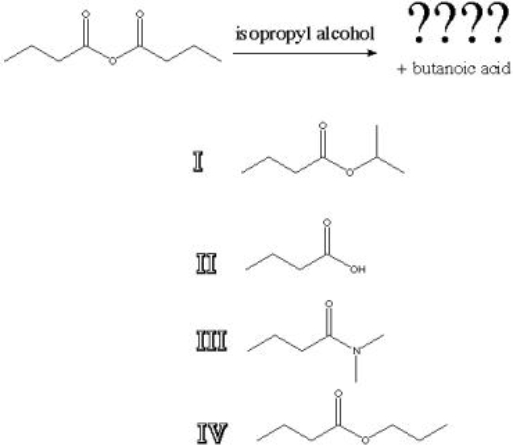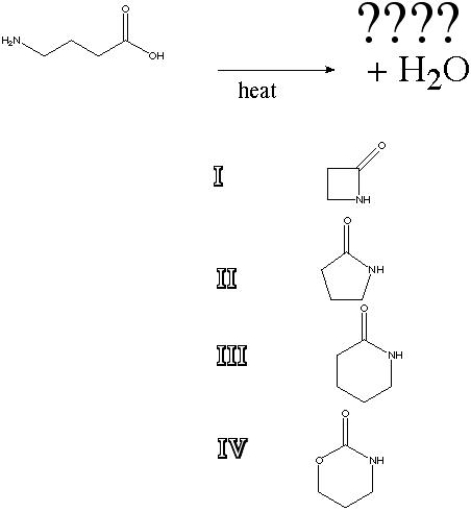Deck 17: Carboxylic Acids and Their Derivatives
Question
Question
Question
Question
Question
Question
Question
Question
Question
Question
Question

Unlock Deck
Sign up to unlock the cards in this deck!
Unlock Deck
Unlock Deck
1/11
Play
Full screen (f)
Deck 17: Carboxylic Acids and Their Derivatives
1
What is correct reagent for the following reaction?

A) I
B) II
C) III
D) IV
E) I and II
F) I and III
G) I and IV
H) all of the above
I) none of the above

A) I
B) II
C) III
D) IV
E) I and II
F) I and III
G) I and IV
H) all of the above
I) none of the above
I and IV
2
The reactivity of carboxylic acid derivatives from highest reactivity to lowest reactivity is ___ .
A) acid anhydride > acid chloride > ester > amide
B) acid chloride > acid anhydride > ester > amide
C) acid anhydride > ester > amide > acid chloride
D) amide > ester > acid anhydride > acid chloride
A) acid anhydride > acid chloride > ester > amide
B) acid chloride > acid anhydride > ester > amide
C) acid anhydride > ester > amide > acid chloride
D) amide > ester > acid anhydride > acid chloride
acid chloride > acid anhydride > ester > amide
3
What is the product of the following reaction? 
A) I
B) II
C) III
D) IV

A) I
B) II
C) III
D) IV
IV
4
What is the product of the following reaction? 
A) I
B) II
C) III
D) IV

A) I
B) II
C) III
D) IV

Unlock Deck
Unlock for access to all 11 flashcards in this deck.
Unlock Deck
k this deck
5
What is the product of the following reaction? 
A) I
B) II
C) III
D) IV

A) I
B) II
C) III
D) IV

Unlock Deck
Unlock for access to all 11 flashcards in this deck.
Unlock Deck
k this deck
6
What is the correct order of reagents to achieve the following synthesis? 
A) 1) TBAF/THF 2) SOCl2 3) H3O+/heat
B) 1) TBAF/THF 2) H3O+/heat
C) 1) NaOH, H2O 2) TBAF/THF 3) H3O+/heat
D) 1) CH3NH2 2) TBAF/THF 3) H3O+/heat

A) 1) TBAF/THF 2) SOCl2 3) H3O+/heat
B) 1) TBAF/THF 2) H3O+/heat
C) 1) NaOH, H2O 2) TBAF/THF 3) H3O+/heat
D) 1) CH3NH2 2) TBAF/THF 3) H3O+/heat

Unlock Deck
Unlock for access to all 11 flashcards in this deck.
Unlock Deck
k this deck
7
What is the correct order of reagents to achieve the following synthesis? 
A) 1) P4O10 heat 2) H3O+ 3) heat
B) 1) H3O+/heat 2) KMnO4, OH-, heat 3) H3O+ 4) heat
C) 1) DIBAL-H 2) H2O 3) SOCl2 4) HBr 5) heat
D) 1) DIBAL-H 2) H2O 3) NH3 4) heat

A) 1) P4O10 heat 2) H3O+ 3) heat
B) 1) H3O+/heat 2) KMnO4, OH-, heat 3) H3O+ 4) heat
C) 1) DIBAL-H 2) H2O 3) SOCl2 4) HBr 5) heat
D) 1) DIBAL-H 2) H2O 3) NH3 4) heat

Unlock Deck
Unlock for access to all 11 flashcards in this deck.
Unlock Deck
k this deck
8
What is the product of the following reaction? 
A) I
B) II
C) III
D) IV

A) I
B) II
C) III
D) IV

Unlock Deck
Unlock for access to all 11 flashcards in this deck.
Unlock Deck
k this deck
9
What is the product of the following reaction? 
A) I
B) II
C) III
D) IV

A) I
B) II
C) III
D) IV

Unlock Deck
Unlock for access to all 11 flashcards in this deck.
Unlock Deck
k this deck
10
What is the product of the following reaction? 
A) I
B) II
C) III
D) IV

A) I
B) II
C) III
D) IV

Unlock Deck
Unlock for access to all 11 flashcards in this deck.
Unlock Deck
k this deck
11
What is the product of the following reaction? 
A) I
B) II
C) III
D) IV

A) I
B) II
C) III
D) IV

Unlock Deck
Unlock for access to all 11 flashcards in this deck.
Unlock Deck
k this deck



